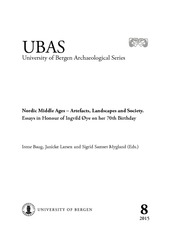| dc.contributor.author | Molaug, Petter B. | |
| dc.contributor.editor | Baug, Irene | |
| dc.contributor.editor | Larsen, Janicke | |
| dc.contributor.editor | Mygland, Sigrid Samset | |
| dc.date.accessioned | 2017-01-16T13:39:02Z | |
| dc.date.available | 2017-01-16T13:39:02Z | |
| dc.date.issued | 2015 | |
| dc.Published | In: Irene Baug, Janicke Larsen and Sigrid Samset Mygland (Eds.), Nordic Middle Ages - Artefacts, Landscapes and Society. Essays in Honour of Ingvild Øye on her 70th Birthday, p 213-226, UBAS - University of Bergen Archaeological Series; 8. | eng |
| dc.identifier.isbn | 978-82-90273-89-2 | |
| dc.identifier.issn | 0809-6058 | |
| dc.identifier.uri | https://hdl.handle.net/1956/15434 | |
| dc.description.abstract | Archaeological research on the medieval town of Oslo from 1970 and onwards has resulted in profound changes in the understanding of the origin and earliest development of the town. The description by Snorri Sturlasson in Heimskringla of the foundation of Oslo by King Harald Hardrada around 1050 was for a long time the main source providing a chronological basis for the origin of the town (Hkr. vol. 3, 153; Fischer 1950, 3-4). Archaeological excavations of areas with ordinary urban habitation and the discovery of graves dated to around AD 1000 have given evidence of earlier occupation (Eide 1974; Schia 1987a; Molaug 2007; Nordeide & Gulliksen 2007). The identification of the king’s palace and the king’s church, St Mary’s, in the south of the town has given a topographical basis for the idea that the town developed towards the north from a primary centre in the south (Christie 1966). The excavations in 1987-1989 on the site Oslo gate 6 in the north of the town, however, shows that the earliest development of the town was much more complicated (Schia 1991a; Molaug et al. 2000; Molaug 2008) (Fig. 1). This article presents some of the evidence from these excavations, along with evidence from other excavations in the northern part of medieval Oslo, primarily the ones in the modern street of Oslo gate just west of Oslo gate 6 in 1987-1988 (Smedstad 1991) and in Arups gate 30 m north of Oslo gate 6 in 2007 (Martens 2010). Based on this presentation, some theories on the role of this area in the late Viking Age and early medieval period are discussed, as well as the background of the nature of habitation from this period. | eng |
| dc.language.iso | eng | eng |
| dc.publisher | University of Bergen | eng |
| dc.relation.ispartof | UBAS - University of Bergen Archaeological Series 8. Nordic Middle Ages - Artefacts, Landscapes and Society. Essays in Honour of Ingvild Øye on her 70th Birthday | |
| dc.relation.ispartofseries | UBAS, University of Bergen Archaeological Series; 8 | eng |
| dc.rights | Attribution CC BY NC SA | eng |
| dc.rights.uri | https://creativecommons.org/licenses/by-nc-sa/3.0 | eng |
| dc.title | From the Farm of Oslo to the Townyard of Miklagard | eng |
| dc.type | Chapter | eng |
| dc.type | Peer reviewed | eng |
| dc.description.version | publishedVersion | |
| dc.rights.holder | Copyright the author | eng |
| dc.source.40 | 8 | |
| dc.source.pagenumber | 213-226 | |
| dc.subject.nsi | VDP::Humaniora: 000::Arkeologi: 090::Nordisk arkeologi: 091 | |

